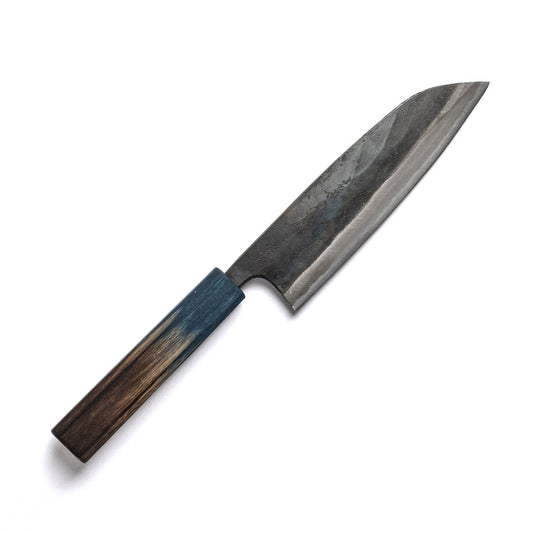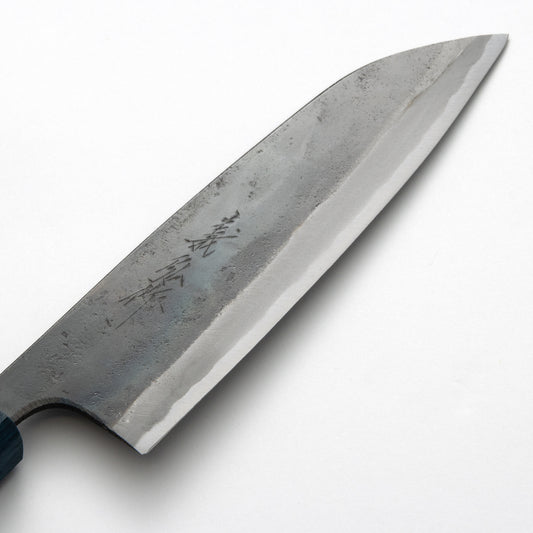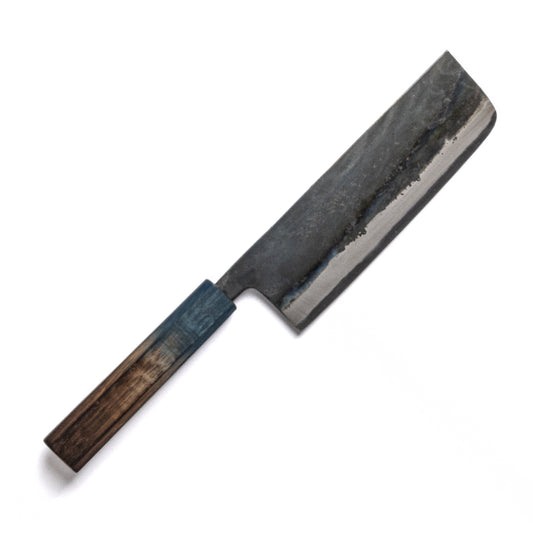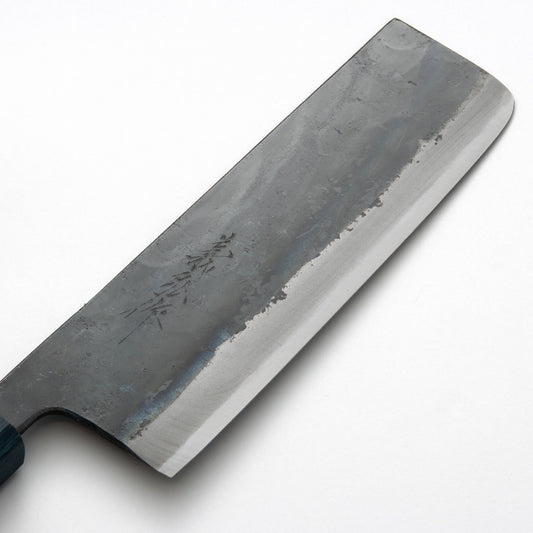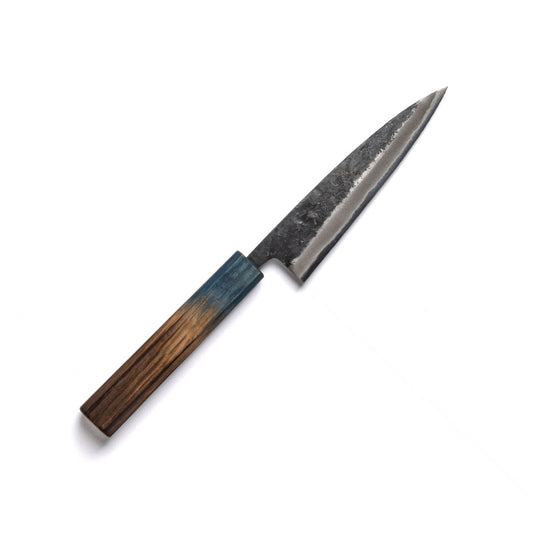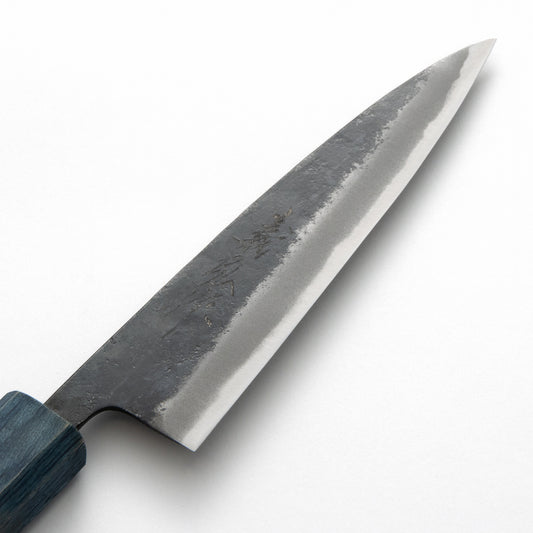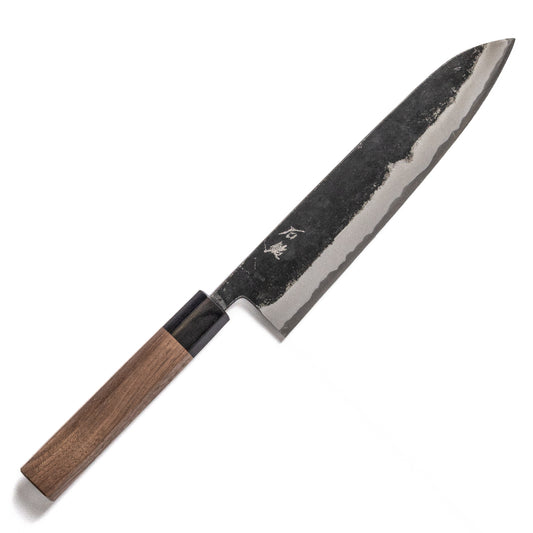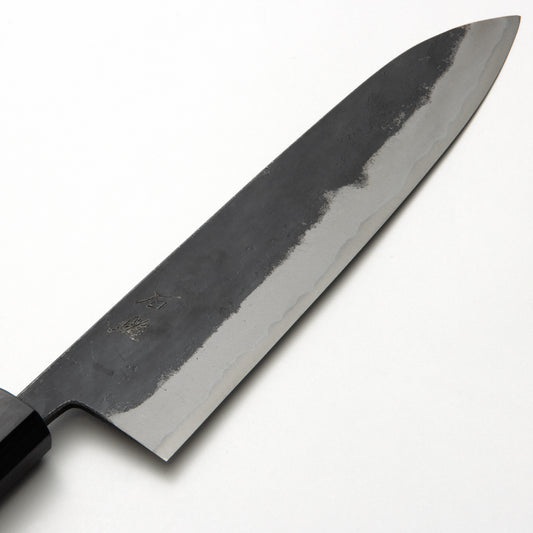Knives are more than mere kitchen tools; they are extensions of a chef's skill and precision. When it comes to knives, two prominent traditions stand out: the Western and Japanese styles. While both are designed for slicing and dicing, they each have unique characteristics that set them apart.
In this comprehensive guide, we'll delve into the differences between Western and Japanese knives, shedding light on their distinct features, craftsmanship, and best-use scenarios.
Contents
- Blade Construction
- Blade Shapel
- Bevel Type
- Cutting Technique
- Maintenance
- Aesthetics
- Cultural History
- In Conclusion
1. Blade Construction

Western Knives: Western knives typically employ a full-tang construction, where the blade extends through the handle, providing durability and balance. The blade is often made of stainless steel, known for its resistance to corrosion and ease of maintenance. Western knives prioritize robustness and are designed to withstand heavy-duty kitchen tasks. The bolster, a thick junction between the blade and handle, contributes to stability and control during cutting.
Japanese Knives: Japanese knives showcase meticulous craftsmanship with a focus on precision. Many Japanese knives feature a laminated or layered construction, with a hard high-carbon steel core surrounded by softer layers. This technique, such as Damascus or honyaki, enhances sharpness and edge retention. Japanese knives often incorporate a partial tang or rat-tail tang, contributing to a lighter feel and nimble handling. The blade material varies, including high-carbon steel and more recently, powdered metallurgy (PM) steel, emphasizing sharpness and edge resilience.
2. Blade Shape

Western Knives: Western knives commonly feature a curved blade profile, creating a gentle belly along the cutting edge. This design aids in rocking motions, making them versatile for tasks like mincing and chopping. The curve provides a larger contact area with the cutting board, offering stability during use. Western knives are designed for efficiency in various kitchen applications, and the curved blade facilitates a rocking motion, reducing the need for lifting the knife during repetitive tasks.
Japanese Knives: Japanese knives often adopt a straighter blade profile, maintaining a more linear edge. This design enhances precision and control, allowing for clean, straight cuts with minimal effort. Japanese knives are tailored for specific cutting techniques, and the straighter blade shape is well-suited for precise tasks like sashimi slicing and vegetable julienning. The straight blade ensures a direct and controlled cut, showcasing the meticulous craftsmanship and attention to detail in Japanese knife design.
3. Bevel Type

Western Knives: Western knives typically feature a double bevel, where both sides of the blade slope towards the center. This symmetrical design facilitates easy sharpening and is well-suited for general-purpose tasks. The V-shaped edge provides durability and stability, making Western knives reliable for heavy-duty chopping and slicing. It accommodates a variety of cutting styles and is user-friendly, making it accessible for chefs of all skill levels.
Japanese Knives: Japanese knives often showcase a single bevel, with one side of the blade forming a steep angle while the other remains flat. This asymmetrical design enhances precision and sharpness, crucial for intricate Japanese culinary techniques. The single bevel allows for more acute angles, resulting in an incredibly sharp edge. Japanese knives, known for their specialization, are often tailored to specific tasks, making them ideal for achieving the utmost precision in slicing, dicing, and other delicate cutting techniques.
4. Cutting Technique

Western Knives: Western knives, designed for versatility, are employed with a variety of cutting techniques. The rocking motion, often associated with chef's knives, facilitates efficient chopping, while the slicing technique is ideal for carving meats. The pointed tip of many Western knives allows for precise piercing, aiding in tasks like boning and trimming. Due to their robust build, these knives excel in heavy-duty tasks, such as breaking down large cuts of meat and tough-skinned vegetables. Western knives offer adaptability across different cutting styles, making them suitable for various culinary applications.
Japanese Knives: Japanese knives, crafted for precision, excel in specific cutting techniques that maximize control and finesse. The draw cut, where the knife is pulled backward or towards the chef, is common, providing meticulous control for intricate tasks like slicing sashimi or julienning vegetables. The push cut, where the knife is pushed forward, is favored for clean, precise cuts. The rocking motion is less pronounced in Japanese knives, emphasizing a smooth, gliding action. These knives often feature a more acute blade angle, enhancing precision for intricate tasks. Japanese knives are revered for their ability to execute delicate cuts with unparalleled sharpness and control.
5. Maintenance

Western Knives: Western knives, designed for durability and versatility, demand a straightforward yet disciplined maintenance routine.
- Regular honing with a honing rod is recommended to keep the blade aligned and sharp.
- When sharpening is required, Western knives typically respond well to honing steels and pull-through sharpeners.
- It's crucial to clean these knives immediately after use to prevent corrosion, and many are dishwasher-safe, simplifying the cleaning process.
However, handwashing and thorough drying are often advised to maintain longevity and prevent wear on handles.
Japanese Knives: Japanese knives, revered for their precision and craftsmanship, require careful and considered maintenance.
- Honing is essential to maintain the edge, but traditional Japanese water stones are often preferred for sharpening due to their ability to achieve razor-sharp edges.
- Cleaning immediately after use is crucial, and many Japanese knives are not dishwasher-safe.
- Handwashing with mild detergent and gentle drying are recommended to preserve the blade and handle materials.
- Additionally, some Japanese knives may benefit from protective storage to prevent damage to the delicate edge.
The meticulous care enhances the longevity of these exceptional blades.
6. Aesthetics

Western Knives: Western Knives showcase a robust and practical design that marries functionality with classic elegance. Influenced by European craftsmanship, these knives often feature full tang construction, bolstered handles, and riveted designs, emphasizing durability and sturdiness.
The aesthetics of Western knives are characterized by a timeless and straightforward elegance, with handles crafted from materials like wood, plastic, or composite materials. The focus is on a comfortable grip and a utilitarian yet refined appearance.
Japanese Knives: Japanese Knives elevate aesthetics to an art form, mirroring the precision and artistry of traditional Japanese craftsmanship. The beauty of Japanese knives lies not just in their functionality but in the meticulous details of their design. Often crafted with Damascus steel, the blades boast intricate patterns reminiscent of folded samurai swords.
The handles, often made from materials like Japanese hardwoods or magnolia, are designed for balance and grace. Japanese knives are not merely tools; they are expressions of cultural heritage, with each knife telling a story through its form, materials, and craftsmanship.
7. Cultural History

Western Knives: Originating from European heritage, these knives historically employed carbon steel and have evolved to embrace stainless steel for corrosion resistance. The German and French influences have given rise to distinctive styles—German knives, like those from Wusthof and Henckels, are known for durability with thicker blades, while French knives, exemplified by brands like Sabatier, feature thinner blades designed for precision.
Emphasizing versatility and ergonomic handles, Western knives reflect a functional approach rooted in European culinary practices.
Japanese Knives: Japanese Knives have a rich heritage deeply connected to samurai craftsmanship, drawing inspiration from sword-making traditions. Crafted from high-carbon and Damascus steel, these knives are celebrated for their razor-sharp precision. Specialized designs like the Santoku and Nakiri cater to specific culinary tasks, reflecting the artistry and meticulous craftsmanship inherent in Japanese culture.
Beyond functionality, Japanese knives incorporate aesthetic elements, making the crafting process an art form. Choosing a Japanese knife goes beyond utility; it aligns with traditional culinary rituals and exemplifies the precision associated with Japanese culinary traditions.
In Conclusion
In the world of culinary craftsmanship, both Western and Japanese knives shine brightly, each with its own set of advantages. Your choice between them ultimately depends on your cooking style, skills, and preferences.
Whether you opt for the versatility of Western knives or the precision of Japanese knives, one thing is certain: a well-crafted knife can elevate your culinary journey to new heights. Understanding the nuances of these knife traditions empowers you to make informed choices and master the art of cutting.





